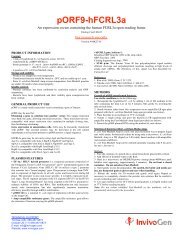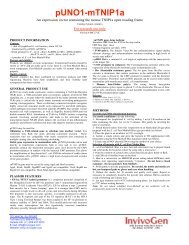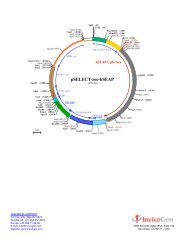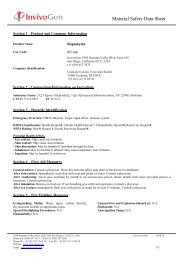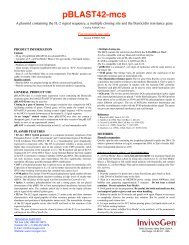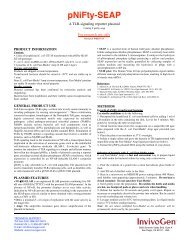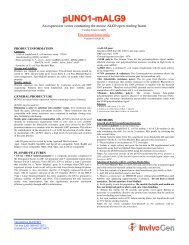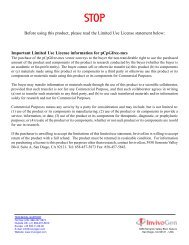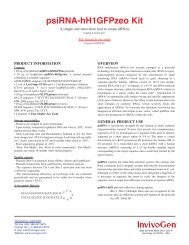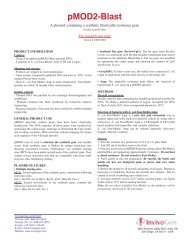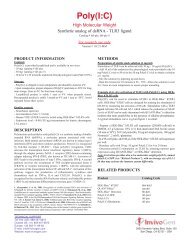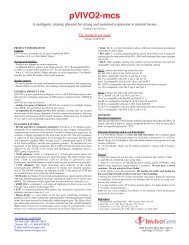HEK-Blue⢠IL-4/IL-13 Cells - InvivoGen
HEK-Blue⢠IL-4/IL-13 Cells - InvivoGen
HEK-Blue⢠IL-4/IL-13 Cells - InvivoGen
Create successful ePaper yourself
Turn your PDF publications into a flip-book with our unique Google optimized e-Paper software.
STAT6 SEAP<br />
JAK1 TyK2<br />
<strong>IL</strong>-<strong>13</strong><br />
<strong>IL</strong>-4<br />
STAT6<br />
<strong>IL</strong>-<strong>13</strong>Rα1<br />
STAT6<br />
STAT6<br />
<strong>IL</strong>-4Rα<br />
P P<br />
STAT6<br />
<strong>HEK</strong>-Blue <strong>IL</strong>-4/<strong>IL</strong>-<strong>13</strong> <strong>Cells</strong><br />
Interleukin-4 and interleukin-<strong>13</strong> sensor cells<br />
Catalog # hkb-stat6<br />
For research use only<br />
Version # 12C15-MM<br />
pRODUCT INfORmaTION<br />
Contents:<br />
• 1 vial of <strong>HEK</strong>-Blue <strong>IL</strong>4/<strong>IL</strong>-<strong>13</strong> <strong>Cells</strong> (5-7 x 10 6 cells)<br />
• 100 µl Blasticidin (10 mg/ml). Store Blasticidin at 4˚C for 6 months<br />
or at -20˚C for 1 year.<br />
• 100 µl Zeocin (100 mg/ml). Store Zeocin at 4˚C for 6 months or<br />
at -20˚C for 1 year.<br />
• 1 ml Normocin (50 mg/ml). Normocin is a formulation of three<br />
antibiotics active against mycoplasmas, bacteria and fungi. Store<br />
at -20°C. Product is stable for 18 months when stored at -20°C.<br />
• 1 pouch of QUANTI-Blue (SEAP detection medium). Store<br />
QUANTI-Blue pouch at room temperature for up to 6 months.<br />
Reconstituted QUANTI-Blue medium is stable 2 weeks at 4˚C.<br />
Keep reconstituted QUANTI-Blue away from light.<br />
Handling <strong>Cells</strong> Upon arrival<br />
We strongly recommend that you propagate the cells, using the<br />
provided procedure, as soon as possible. This will ensure the best cell<br />
viability and assay performance. Frozen cells may be placed in liquid<br />
nitrogen until you are ready to thaw and propagate them, however,<br />
this may reduce cell viability.<br />
product Warranty<br />
<strong>InvivoGen</strong> warrants that cells shall be viable upon shipment from<br />
<strong>InvivoGen</strong> for a period of thirty days, provided they have been<br />
properly stored and handled during this period.<br />
Cell line stability<br />
<strong>Cells</strong> will undergo genotypic changes resulting in reduced<br />
responsiveness over time in normal cell culture conditions. Genetic<br />
instability is a biological phenomenon that occurs in all stably<br />
transfected cells. Therefore, it is critical to prepare an adequate<br />
number of frozen stocks at early passages.<br />
<strong>HEK</strong>-Blue <strong>IL</strong>4/<strong>IL</strong>-<strong>13</strong> cells should not be passaged more than 20<br />
times to remain fully efficient. <strong>HEK</strong>-Blue <strong>IL</strong>4/<strong>IL</strong>-<strong>13</strong> cells should be<br />
maintained in Growth Medium supplemented with the two selective<br />
antibiotics, Zeocin (100 mg/ml) and Blasticidin (10 µg/ml).<br />
Antibiotic pressure with Blasticidin is required to maintain the<br />
plasmid coding for human STAT6 gene and Zeocin is required to<br />
maintain the plasmid coding for SEAP.<br />
INTRODUCTION<br />
The transcription factor STAT6 is<br />
activated primarily by two cytokines<br />
with overlapping biologic functions,<br />
<strong>IL</strong>-4 and <strong>IL</strong>-<strong>13</strong>. It can also be<br />
activated by IFN-a in a cell-specific<br />
manner. In non-hematopoietic<br />
cells, <strong>IL</strong>-4 and <strong>IL</strong>-<strong>13</strong> bind a<br />
receptor complex composed of<br />
the <strong>IL</strong>-4Ralpha and <strong>IL</strong>-<strong>13</strong>Ralpha1.<br />
Upon ligand binding, the receptor<br />
complex activates the receptorassociated<br />
Janus kinases (JAK1 and<br />
Tyk2) leading to the recruitment of<br />
STAT6 and its phosphorylation.<br />
Activated STAT6 forms homodimers<br />
that translocate to the nucleus where<br />
they bind the promoter of responsive<br />
genes inducing gene transcription.<br />
<strong>IL</strong>-4<br />
<strong>IL</strong>-<strong>13</strong><br />
TyK2<br />
<strong>IL</strong>-4Rα<br />
<strong>IL</strong>-<strong>13</strong>Rα1<br />
JAK1<br />
P P<br />
STAT6<br />
STAT6<br />
STAT6<br />
SEAP<br />
Cell lINe DesCRIpTION<br />
<strong>HEK</strong>-Blue <strong>IL</strong>-4/<strong>IL</strong>-<strong>13</strong> <strong>Cells</strong> are specifically designed to monitor<br />
the activation of the STAT6 pathway induced by <strong>IL</strong>-4 and <strong>IL</strong>-<strong>13</strong><br />
(and IFNa). These cells were generated by stably introducing the<br />
human STAT6 gene into <strong>HEK</strong>293 cells to obtain a fully active<br />
STAT6 signaling pathway. The other genes of the pathway are<br />
naturally expressed in sufficient amounts. Furthermore,<br />
<strong>HEK</strong>-Blue <strong>IL</strong>-4/<strong>IL</strong>-<strong>13</strong> <strong>Cells</strong> stably express the reporter gene<br />
secreted embryonic alkaline phosphatase (SEAP) under the control<br />
of the IFNb minimal promoter fused to four STAT6 binding sites.<br />
Activation of the STAT6 pathway in <strong>HEK</strong>-Blue <strong>IL</strong>-4/<strong>IL</strong>-<strong>13</strong> <strong>Cells</strong><br />
induces the expression of the reporter gene. SEAP which is<br />
secreted in the supernatant is easily detectable when using<br />
QUANTI-Blue a medium that turns purple/blue in the presence of<br />
SEAP.<br />
Quality control:<br />
Expression of STAT6 was confirmed by RT-PCR. <strong>HEK</strong>-Blue <br />
<strong>IL</strong>-4/<strong>IL</strong>-<strong>13</strong> <strong>Cells</strong> were stimulated by various cytokines. Production of<br />
SEAP was detected following stimulation by <strong>IL</strong>-4, <strong>IL</strong><strong>13</strong> and and also<br />
type I IFNs (essentially IFN-a) but to a lesser extent. These cells are<br />
guaranteed mycoplasma-free.<br />
STAT6<br />
STAT6<br />
TECHNICAL SUPPORT<br />
Toll free (US): 888-457-5873<br />
Outside US: (+1) 858-457-5873<br />
Europe: +33 562-71-69-39<br />
E-mail: info@invivogen.com<br />
Website: www.invivogen.com<br />
3950 Sorrento Valley Blvd. Suite 100<br />
San Diego, CA 92121 - USA
safeTy CONsIDeRaTIONs<br />
Biosafety level 2.<br />
HaNDlINg pROCeDURes<br />
Required Cell Culture medium<br />
• Growth Medium: DMEM, 4.5 g/l glucose, 10% (v/v) fetal bovine<br />
serum, 50 U/ml penicillin, 50 mg/ml streptomycin, 100 mg/ml<br />
Normocin , 2 mM L-glutamine<br />
• Freezing Medium: DMEM with 20% fetal bovine serum and 10%<br />
(v/v) DMSO<br />
• Test Medium: DMEM, 4.5 g/l glucose, 10% (v/v) heat-inactivated<br />
fetal bovine serum (30 min at 56ºC), 50 U/ml penicillin, 50 mg/ml<br />
streptomycin, 100 mg/ml Normocin , 2 mM L-glutamine<br />
Note: Heat-inactivated FBS is also commercially available.<br />
frozen cells<br />
1- Thaw the vial by gentle agitation in a 37°C water bath. To reduce<br />
the possibility of contamination, keep the O-ring and cap out of the<br />
water. Thawing should be rapid.<br />
2- Remove the vial from the water bath as soon as the contents are thawed,<br />
and decontaminate by dipping in or spraying with 70% ethanol.<br />
Note: All of the operations from this point should be carried out under<br />
strict aseptic conditions.<br />
3- Transfer cells in a larger vial containing 15 ml of pre-warmed<br />
Growth Medium. Do not add selective antibiotics until the cells<br />
have been passaged twice.<br />
4- Centrifuge vial at 1000-1200 RPM (RCF 200-300 g) for 5 minutes.<br />
5- Remove supernatant containing the cryoprotective agent and resuspend<br />
cells with 1 ml of growth medium without selective antibiotics.<br />
6- Transfer the vial contents to a T-25 tissue culture flask containing 5 ml<br />
of growth medium without selective antibiotics.<br />
7- Place the culture at 37˚C in 5% CO2.<br />
Day 2:<br />
- Prepare QUANTI-Blue following the instructions on the pouch.<br />
- Add 180 ml of resuspended QUANTI-Blue per well of a<br />
flat-bottom 96-well plate.<br />
- Add 20 ml of induced <strong>HEK</strong>-Blue <strong>IL</strong>-4/<strong>IL</strong>-<strong>13</strong> <strong>Cells</strong> supernatant.<br />
- Incubate the plate at 37°C incubator for 1-3 h.<br />
- Determine SEAP levels using a spectrophotometer at 620-655 nm.<br />
Use ResTRICTIONs<br />
These cells are distributed for research purposes only.<br />
This product is covered by a Limited Use License. By use of this<br />
product, the buyer agrees the terms and conditions of all applicable<br />
Limited Use Label Licenses. For non-research use, such as screening,<br />
quality control or clinical development, contact info@invivogen.com<br />
RelaTeD pRODUCTs<br />
product<br />
Blasticidin (100 mg)<br />
Zeocin (1 g)<br />
Normocin <br />
QUANTI-Blue (5 pouches)<br />
Catalog Code<br />
ant-bl-1<br />
ant-zn-1<br />
ant-nr-1<br />
rep-qb1<br />
Cell maintenance<br />
- Maintain and subculture the cells in growth medium supplemented<br />
with 10 µg/ml of blasticidin and 100 µg/ml of Zeocin .<br />
- Renew growth medium 2 times a week.<br />
- <strong>Cells</strong> should be passaged when a 70-80% confluency is reached. Do<br />
not let the cell grow to 100% confluency.<br />
Il-4/Il-<strong>13</strong> Detection<br />
Day 1:<br />
- Add 20 ml of each sample per well of a flat-bottom 96-well plate.<br />
- Add 20 ml of <strong>IL</strong>-4 or <strong>IL</strong>-<strong>13</strong> at 10 ng/ml (positive control) in one well.<br />
- Add 20 ml of TNF-a at 100 ng/ml (negative control, other cytokines<br />
can be used) in one well.<br />
- Prepare a cell suspension of <strong>HEK</strong>-Blue <strong>IL</strong>-4/<strong>IL</strong>-<strong>13</strong> <strong>Cells</strong><br />
at ~280,000 cells per ml in test medium (containing 10% v/v<br />
heat-inactivated FBS).<br />
Note: Some FBS may contain alkaline phosphatases that can interfere<br />
with SEAP quantification.We recommend to use heat-inactivated FBS<br />
to inactivate these enzymes which are thermosensitive.<br />
- Add 180 ml of cell suspension (~50,000 cells) per well.<br />
- Incubate the plate at 37°C in a CO2 incubator for 20-24 h.<br />
TECHNICAL SUPPORT<br />
Toll free (US): 888-457-5873<br />
Outside US: (+1) 858-457-5873<br />
Europe: +33 562-71-69-39<br />
E-mail: info@invivogen.com<br />
Website: www.invivogen.com<br />
3950 Sorrento Valley Blvd. Suite 100<br />
San Diego, CA 92121 - USA



